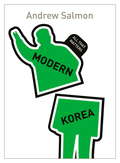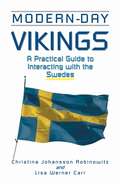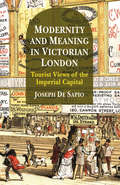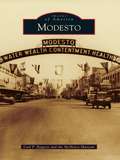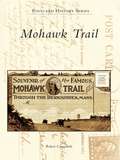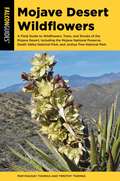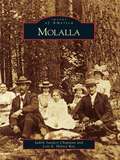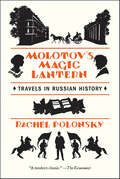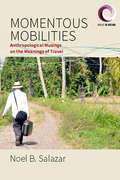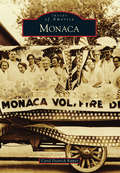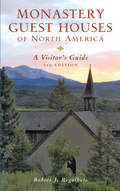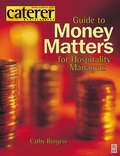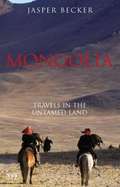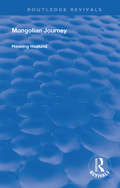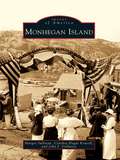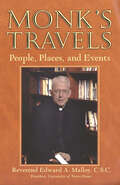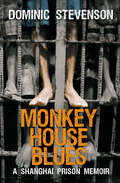- Table View
- List View
Modern Korea: All That Matters Ebook (All That Matters)
by Andrew SalmonIn no nation on earth has history accelerated with such speed as in Korea. A medieval dynasty at the end of the 19th century, it underwent a traumatic colonization, then, in its hour of liberation was divided by the great powers at the end of World War II. Devastated by a fratricidal war, the peninsula has remained divided ever since.South Korea is the greatest national success story of the 20th century. From the ashes of war, it transformed itself, against the odds - and against much advice - into an industrial powerhouse and thriving democracy. Now a high-tech wonderland, it is undergoing social and cultural transformations that add further layers to its dynamic DNA.North Korea is an economic, social and political disaster, successful only at totalitarianism. Having transmogrified from a blood-and-iron communist dictatorship into a bizarre, neo-fascist monarchy, it is a black hole at the heart of Asia. Engulfed by paranoia, the regime presides over a malnourished populace, a 1.1 million man army and a nuclear arsenal. From nuclear missiles to Samsung smartphones; from assassins to salarymen; from Kim Il-sung to Psy; this is the extraordinary story of the flashpoint peninsula that dominates talk in boardrooms and newsrooms. Korea, the author argues, provides two stark benchmarks for national development: Epic success and catastrophic failure. And its final chapter has yet to be written.
Modern-Day Vikings: A Pracical Guide to Interacting with the Swedes
by Christina Johansson Robinowitz Lisa Werner CarrA window into Swedish culture, Modern Day Vikings: A Practical Guide to Interacting with the Swedes examines Sweden's social model and underlying values. Christina Robinowitz and Lisa Carr provide a window into the Swedish heritage of self-sufficiency, fairness, egalitarianism and democracy, breaking through the stereotypes often associated with the country.
Modernes Hospitality Marketing: Grundlagen, Strategien und Instrumente für einen wertschöpfungsstarken Tourismus
by Oliver Errichiello Sandra BayerDieses Buch bietet einen fundierten Überblick über die aktuellen Herausforderungen im Tourismus und zeigt Lösungsansätze für ein wertschöpfendes Hospitality Marketing auf. Weltweite Krisen, Digitalisierung und Umweltbewusstsein haben das Reise- und Buchungsverhalten massiv verändert. Das Verlangen nach Urlaub ist zwar ungebrochen, doch der qualitative Anspruch an Hotels, Gastronomie und andere Dienstleister in den Destinationen steigt. Es gilt, die Erwartungen von Reisenden einfach, individuell, facettenreich sowie preislich adäquat und nachhaltig zu erfüllen.Die Autoren zeigen, wie diese komplexe Aufgabe vor dem Hintergrund hoher Fix- und Entwicklungskosten, kompetitiver Verdrängungsmärkte sowie verschärfter gesetzlicher Regulierungen gemeistert werden kann. Sie verknüpfen markensoziologische mit betriebswirtschaftlichen Erkenntnissen und Best Practice Insights, sodass Studierende und Praktiker gleichermaßen von der Lektüre des Buches profitieren.
Modernist Voyages
by Anna SnaithLondon's literary and cultural scene fostered newly configured forms of feminist anticolonialism during the modernist period. Through their writing in and about the imperial metropolis, colonial women authors not only remapped the city, they also renegotiated the position of women within the empire. This book examines the significance of gender to the interwoven nature of empire and modernism. As transgressive figures of modernity, writers such as Jean Rhys, Katherine Mansfield, Una Marson and Sarojini Naidu brought their own versions of modernity to the capital, revealing the complex ways in which colonial identities 'traveled' to London at the turn of the twentieth century. Anna Snaith's timely and original study provides a new vantage point on the urban metropolis and its artistic communities for scholars and students of literary modernism, gender and postcolonial studies, and English literature more broadly.
Modernity and Meaning in Victorian London
by Joseph De SapioJoseph De Sapio examines how individuals not only understood their contacts with industrial modernity as distinct from the inherited traditional rhythms of the eighteenth century, but how they conceived of their own positions within the increasingly sophisticated political, social, and commercial paradigms of the Victorian years.
Modesto
by Carl P. Baggese Mchenry MuseumSettled in 1870 by the Central Pacific Railroad, Modesto is located in California's agriculturally rich Central Valley. The new town was to be named after the prominent California banker W. C. Ralston, but, as city lore and legend tell it, his "modest" refusal led to the name Modesto. Originally a wheat-producing region, the city blossomed with the arrival of irrigation, and fruit orchards and vineyards soon grew in abundance. The county seat of Stanislaus County, Modesto became an agricultural hub, with the motto "Water Wealth Contentment Health" emblazoned on an iconic arch at the town's entrance. California's original junior college is located here along with E. & J. Gallo Winery, the world's largest privately held winery, family run since 1933. Twice named an All American City, Modesto inspired native son George Lucas when he made his classic American Graffiti in 1973.
Mohawk Trail (Postcard History Series)
by Robert CampanileThe Mohawk Trail evokes visions of the ancient, recalls an abundance of historic incidents, and etches memories of nature's bounty. The trail weaves a fabric of both old and modern footprints through a historic college campus, past a fort under siege, down an old mill town's Main Street, up a barrier mountain, around a harrowing curve, and through aweinspiring expanses of nature's finest work. Nothing paints the enchantment of the trail better than the vintage postcards of the early to mid1900s. Mohawk Trail takes the reader on a postcard vacation, retracing the footsteps of the Native Americans and first settlers who made these valleys their home.
Mojave Desert Wildflowers: A Field Guide to Wildflowers, Trees, and Shrubs of the Mojave Desert, Including the Mojave National Preserve, Death Valley National Park, and Joshua Tree National Park (Wildflower Series)
by Pam Mackay Thomas Timothy ThomasThe Mojave Desert eco-region extends from eastern California to northwestern Arizona, southern Nevada, and southwestern Utah, and boasts plant communities as diverse as alkali sinks, dune systems, Joshua tree woodland, pinyon juniper woodland, mixed mojave scrub, and even riparian woodland. This fully updated and revised edition will be appreciated not only by amateur wildflower enthusiasts, but experts will also find the detailed photographs and charts useful in distinguishing among similar species in difficult groups. Species are arranged by color and plant family for easy identification. This guide features 300 of the common species, full-color photographs (many brand new to this edition), detailed descriptions, information on bloom season, and interesting facts about each plant.
Molalla
by Lois E. Ray Judith Sanders ChapmanMolalla is a small community on the edge of the Willamette Valley where some of the first Oregon Trail settlers arrived in the 1840s. Thirty miles south of Portland and north of Oregon's capital at Salem, Molalla rests snugly against the foothills of the Cascade Mountains, watched over by snowcapped Mount Hood. Though close to the region's first capital at historic Oregon City, Molalla is an independent Western town famous for its annual Fourth of July Buckeroo rodeo and parade. Molalla grew as an important agricultural trade center but is best known for its logging operations and abundant lumber mills. People had long visited summer resorts along the Molalla River and rejuvenated at the now-vanished Wilhoit Mineral Springs resort. Molalla retains its small-town atmosphere and independent spirit, not unlike the pioneer forebears who made the Molalla Prairie their home.
Molotov's Magic Lantern: Travels in Russian History
by Rachel PolonskyWhen the British journalist Rachel Polonsky moves to Moscow, she discovers an apartment on Romanov Street that was once home to the Soviet elite. One of the most infamous neighbors was the ruthless apparatchik Vyacheslav Molotov, a henchman for Stalin who was a participant in the collectivizations and the Great Purge—and also an ardent bibliophile. In what was formerly Molotov's apartment, Polonsky uncovers an extensive library and an old magic lantern—two things that lead her on an extraordinary journey throughout Russia and ultimately renew her vision of the country and its people.In Molotov's Magic Lantern, Polonsky visits the haunted cities and vivid landscapes of the books from Molotov's library: works by Chekhov, Dostoevsky, Pushkin, Akhmatova, and others, some of whom were sent to the Gulag by the very man who collected their books. With exceptional insight and beautiful prose, Polonsky writes about the longings and aspirations of these Russian writers and others in the course of her travels from the Arctic to Siberia and from the forests around Moscow to the vast steppes. A singular homage to Russian history and culture, Molotov's Magic Lantern evokes the spirit of the great artists and the haunted past of a country ravaged by war, famine, and totalitarianism.
Momentous Mobilities: Anthropological Musings on the Meanings of Travel (Worlds in Motion #4)
by Noel B. SalazarGrounded in scholarly analysis and personal reflection, and drawing on a multi-sited and multi-method research design, Momentous Mobilities disentangles the meanings attached to temporary travels and stays abroad and offers empirical evidence as well as novel theoretical arguments to develop an anthropology of mobility. Both focusing specifically on how various societies and cultures imagine and value boundary-crossing mobilities “elsewhere” and drawing heavily on his own European lifeworld, the author examines momentous travels abroad in the context of education, work, and spiritual quests and the search for a better quality of life.
Moms Who Hike: Walking with America's Most Inspiring Adventurers
by Heather Balogh RochfortMoms Who Hike celebrates the athleticism, wisdom, and skill of over twenty of America&’s most inspiring adventurer mothers ranging from legends to rising stars of today. The book is both inspirational and aspirational as each adventurer tells her story in her own words through featuring their favorite hike, highlighting personal challenges, accomplishments, and philosophy, as well as providing readers with practical how-to suggestions on maximizing not only their own potential in hiking but in life. The profiles are complemented by stunning color photographs. Each profile includes a map of the hike being profiled, hike specs, miles and directions, GPS coordinates to the trailhead, and a sidebar of something noteworthy about the hike, the location, or the adventurer.
Monaca
by Carol Dietrich RipperMonaca is a Beaver County river town located 25 miles north of Pittsburgh, Pennsylvania. It was founded by dissidents of the Harmony Society in 1832. Their New Philadelphia Society lasted less than two years, but many settlers stayed and laid the foundation for the community they named Phillipsburg. In 1892, the name of the town was changed to Monaca in honor of the Iroquois chief Monacatootha. Monaca will take readers on a journey down memory lane to visit businesses such as Hahn and Reno Furniture, Callaghans Pharmacy, Balamut Electric Shop, Frank's Place, Graters Dairy Bar, Heckman's Hardware Store, M.W. Carey Grocer, and H.C. Weirich Bakery. The town's rich history is relived with stories about its churches, schools, hotels, bridges, and people. In 1892, the Phoenix Glass Company began production; it would survive four devastating fires and become part of Anchor Hocking Glass Company. These stories and many others are waiting to be told in Monaca.
Monastery Guest Houses of North America: A Visitor's Guide (Fifth Edition)
by Robert J. Regalbuto"An invitation to share, if briefly, in the contemplative spirit of monastic life."--National Geographic Traveler For centuries monasteries have been places of solitude and retreat. Many monasteries and convents offer hospitality to those seeking a quiet place and a time of purposeful rest, reflection, and renewal. This book is your guide to guesthouses at convents and monasteries throughout the United States and Canada. Each chapter includes contact information, directions by car and by public transportation, accommodations offered, meals provided, charges, each place's history and description, nearby points of interest, and special notes; illustrations and a helpful index round out the book. Locations range from Midtown Manhattan to the Pacific Coast, Chicago to Florida's orange groves. The cost of these lodgings is surprisingly low-- ideal for budget travelers. The monasteries and convents featured span a spectrum of Christian traditions, yet each is open to pilgrims of any faith.
Money Matters for Hospitality Managers (Caterer And Hotelkeeper Guide To. . . Ser.)
by Cathy BurgessUnique in its approach, 'Money Matters for Hospitality Managers' is unlike other heavy theoretical accounting texts, using real life scenarios to show managers how it's done. Backed up by a range of exercises and activities, it thus allows managers to put their learning straight into practice - and so to achieve immediate results! 'Money Matters' will actively help managers and employees in the industry to:· learn more about the control aspects in order to become more effective in their work· learn about the business and companies in the wider context· understand where their section of the organization fits in the 'bigger picture'· increase their knowledge and enhance career opportunitiesCovering an unprecedented range of sectors (including hotels, restaurants, contract catering, leisure tourism, cruise ships and theme parks), the book supplies useful advice for the whole hospitality industry. It is ideal for operational and first line management, for whom it provides a welcome, accessible and hands-on introduction to finance and accounting in their sector.
Mongolia - Culture Smart!
by Alan SandersMongolia is landlocked between its neighbors China and Russia in the heart of Asia. For centuries after the disintegration of Genghis Khan's empire it was ruled by one or the other, but in 1990 the Mongols embraced democracy. Now, after two centuries of Manchu stagnation and seventy years of Soviet communism, they are rebuilding their national heritage. Rarely in the news but making progress toward a market economy, this resource-rich but infrastructure-poor country is a land of pioneers, and its greatest asset is the Mongol people, who are friendly, cooperative, ambitious, and well educated. English is now the first foreign language and the country's leaders are forging new partnerships with international investors. Travelers from across the world are drawn to the "land of blue sky" by its picturesque mountains and lakes, flower-carpeted steppes and stony deserts, home to the snow leopard, the wild horse and camel, and the Gobi bear. The broad pasturelands, with herds of grazing livestock, and the traditional lifestyle of the nomads contrast with the busy streets of the capital Ulan Bator, a bustling metropolis of over one million people, modern hotels, apartments, and shops, interspersed with Buddhist monasteries and temples, surrounded by crowded suburbs of traditional felt tents. Mongolia's many attractions range from dinosaur skeletons and the remains of ancient civilizations to relics and reenactments of the Genghis Khan era, and the traditional sports of wrestling, archery, and horse-racing. Culture Smart! Mongolia provides rare insights into contemporary Mongolian society, and offers practical tips on what to expect and how to conduct yourself in order to get the most out of your visit. Despite the undeniable challenges posed by modernity, these warm, tough, adaptable, and hospitable people welcome visitors and are open to the world.
Mongolia: Travels in the Untamed Land
by Jasper BeckerFor seventy years Mongolia was all but closed to the west - a forbidden country, shrouded in darkness. Jasper Becker had long dreamed of exploring the sweeping land that lay just beyond China's Great Wall and when communism disintegrated, he finally did. Setting out from Kublai Khan's capital, Beijing, Becker was one of the first westerners to cross the border. Tracing the course of the Yellow River, he ventured deep into the heart of Mongolia, witnessing the birth of one of the world's youngest democracies as well as the deep and tragic impact of the rules of Mao and Stalin on the Mongolian people. Unraveling the history of Mongolia which had for so long been obscured and distorted, Becker traces the rise and fall of the Mongols who emerged from the steppes to forge one of the greatest and most feared empires of all time under Genghis Khan and his successors; he examines the shattering, divisive years of communist rule and explores present-day Mongolia, where poverty and the encroachments of westernisation cause as much damage. He goes in search of the fragile remnants of Buddhism and shamanism; visits Tuva - the lost world of Central Asia - and searches for the tomb of Genghis Khan which has been guarded and hidden by the same family for generations. Listening to the pulse of Central Asian history, Becker adorns his narrative with the stories of past travellers, tyrannical rulers, nomads, monks, missionaries, Russian officials, Mongolian activists and the memories of everyday people to paint a moving and enlightening portrait of Mongolia, a country that against all the odds has survived since the days of Genghis Khan and continues to beat to its own rhythm.
Mongolian Journey (Routledge Revivals)
by Henning HaslundOriginally published in 1946, Mongolian Journey follows Henning Haslund's trip across Mongolia, inspired by the 'desire to see what was hidden on the other side of the farthest of all known passes.' It includes chapters on the younger generation of Mongolia, robber life in Mongolia, and Jasaktu Land, among many others.
Monhegan Island (Images of America)
by John J. Galluzzo Margot Sullivan Cynthia Hagar KrusellThe natural beauty of Monhegan Island has continuously attracted generations of artists, day-trippers, and summer sojourners. White Head, Pulpit Rock, and Cathedral Woods are names that resonate throughout New England and beyond. Long before the first ferry full of seasonal visitors arrived, the Monhegan Island fishermen had established a permanent community on the island, scratching out an existence on a remote offshore outpost. As early as 1890, prominent artists Robert Henri and George Bellows, followed by Rockwell Kent and Jamie Wyeth, captured the magnificence of Monhegan. They shared the cliffs and coves with the lighthouse keepers, carpenters, lobstermen, and the island people.
Monhegan: A Guide to Maine's Fabled Islands
by Mark WarnerWhat draws visitors to Monhegan-a small island off mid-coast Maine? It is not just the island's timeless atmosphere and beauty but the quality of the light that has always been a magnet to artists and photographers, as well as to vacationers. Now nature photographer and writer Mark Warner has produced a keepsake-cum-guidebook that is a must-have for anyone who visits-or dreams of visiting-one of Maine's most fabled islands.
Monitoring for a Sustainable Tourism Transition: The Challenge of Developing and Using Indicators
by Graham Miller Louise Twining-WardSustainable tourism is not a static target, but a dynamic process of change, a transition. This book considers how monitoring using indicators can assist tourism to make such a sustainability transition. It encourages the reader to view tourism from a broad, interdisciplinary perspective and draws on material from a wide range of sources. The book explains why monitoring is important for different groups of stakeholders; public and private sector, NGOs and communities. It also examines important monitoring considerations such as what and where to measure, how much will monitoring cost and how the data can be presented. The book puts particular emphasis on indicator use and implementation. It highlights the process and techniques to develop and use indicators and then provides clear and detailed examples of monitoring in practice around the globe at different geographic scales.
Monk's Travels: People, Places, and Events
by Edward A. MalloyA memoir of adventures around the world, meetings with famous figures, and journeys both physical and spiritual, from a former president of Notre Dame.Anne Tyler wrote a novel called The Accidental Tourist about a man who is forced to travel but does not want to have any new experiences...My goal on my trips has been just the opposite: not to do anything too foolish, but to be open to an endless round of new experiences and possibilities . . .Father Edward Malloy never planned to share his trip diaries with readers throughout the world. Affectionately known as “Monk,” the president of the University of Notre Dame just wanted to record where he went, what he saw, and whom he met along the way. But good reading attracts readers, and good travel writing takes those readers along on the journey. Both apply to Monk’s Travels.Carrying readers to destinations ranging from New York just after September 11, 2001, to Europe, the Mediterranean, Latin America, Africa, and the Far East, Monk meets and experiences the local residents and their customs. But he also comes in contact with such notable personalities as Presidents George H.W. and George W. Bush, Martin Luther King Jr., Pope John Paul II, and Taiwanese Premier Lien Chen and President Lee Teng-Hui. His reportage of these places and personages opens the world to readers of all faiths and interests. Monk’s Travels shares its creator’s personality, hopes, spirituality, and emotions—and will interest anyone curious about higher education, Catholicism, travel, or recent history.Includes photographs
Monkey Dancing: A Father, Two Kids, And A Journey To The Ends Of The Earth
by Daniel GlickAn inspiring globe-trotting road trip with a personal and environmental agenda. . . definitely an armchair trip worth taking. "?Seattle Post-Intelligencer"
Monkey House Blues: A Shanghai Prison Memoir
by Dominic StevensonIn 1993, Dominic Stevenson left a comfortable life with his girlfriend in Kyoto, Japan, to travel to China. His journey took him to some of the most inhospitable and dangerous places in the world, from the poppy fields of the Afghan-Pakistan border to the ancient trade routes of the Silk Road, before he was arrested for drug smuggling while boarding a boat from Shanghai to Japan. After eight months on remand in a Chinese police lock-up, Stevenson was sentenced to two and a half years in one of the biggest prisons in the world, the Shanghai Municipal Prison aka 'The Monkey House'. There, he was imprisoned alongside just five westerners amongst five thousand Chinese criminals in a block for death row inmates and political prisoners, where the guards drank green tea and let the prison run itself. The experience led him to reflect on his previous life in Japan, India and Thailand, during which time he took on a varied array of jobs, including English teacher, karaoke-bar host, factory worker, busker, crystal seller and dope smuggler. From Afghan gun shops to Tibetan monasteries, Thai brothels and the stirrings of the rave culture in Goa, Monkey House Blues is a tale of discovery and rediscovery, of friendship and betrayal.
Monkeys Are Made Of Chocolate: Exotic And Unseen Costa Rica
by Daniel Quinn Jack EwingDiscover the mysterious and fascinating ways in which animals, plants and people interact with one another in the rainforests of Costa Rica. Teachers, travelers to Costa Rica, and those individuals who care about our environment will appreciate these 32 essays. "This book is perfect reading for every inquisitive traveler to Costa Rica," says Rob Rachowiecki, author of the first five editions of the Lonely Planet Costa Rica guidebook.
